
Dianthus caryophyllus, commonly known as carnation or clove pink, is a species of Dianthus native to the Mediterranean region. Its exact natural range is uncertain due to extensive cultivation over the last 2,000 years. Carnations are prized for their vibrant colors, delicate fringed petals, and enchanting fragrance.
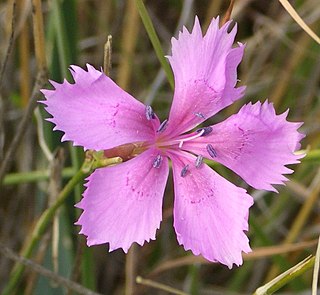
Dianthus is a genus of about 340 species of flowering plants in the family Caryophyllaceae, native mainly to Europe and Asia, with a few species in north Africa and in southern Africa, and one species in arctic North America. Common names include carnation, pink and sweet william.

Anigozanthos is a genus of plant found naturally in the Southwestern Australia biogeographic region, belonging to the bloodwort family Haemodoraceae. The 11 species and their subspecies are commonly known as kangaroo paw or catspaw, depending on their size, and the shape and colour of their flowers. A further species, previously identified as Anigozanthos fuliginosus, was separated to a monotypic genus as Macropidia fuliginosa. All 11 species of Anigozanthos are endemic to the south west of Western Australia, Noongar Boodjar.

Jean-François Séguier was a French archaeologist, epigraphist, astronomer and botanist from Nîmes.

Dianthus barbatus, the sweet William, is a species of flowering plant in the family Caryophyllaceae, native to southern Europe and parts of Asia. It has become a popular ornamental garden plant. It is a herbaceous biennial or short-lived perennial plant growing to 13–92 cm tall, with flowers in a dense cluster of up to 30 at the top of the stems. Each flower is 2–3 cm diameter with five petals displaying serrated edges. Wild plants produce red flowers with a white base, but colours in cultivars range from white, pink, red, and purple to variegated patterns. The exact origin of its English common name is unknown but first appears in 1596 in botanist John Gerard's garden catalogue. The flowers are edible and may have medicinal properties. Sweet William attracts bees, birds, and butterflies.

Dianthus deltoides, the maiden pink, is a species of Dianthus native to most of Europe and western Asia. It can also be found in many parts of North America, where it is an introduced species.

Dianthus armeria, the Deptford pink or grass pink, is a species of Dianthus ("pink") native to most of Europe, from Portugal north to southern Scotland and southern Finland, and east to Ukraine and the Caucasus. It is naturalised in North America.

Dianthus gratianopolitanus, commonly known as the Cheddar pink or clove pink, is a species of plant in the family Caryophyllaceae. It is a herbaceous perennial, hardy to zones 4–8. It grows to a height of 0.5 to 1 feet, blooming from May to June. Flowers are fragrant and rose pink. Grows best in full sun, and has medium water requirements. Overwatering or poor drainage leads to crown rot, and plants do not tolerate wet winter soil conditions.
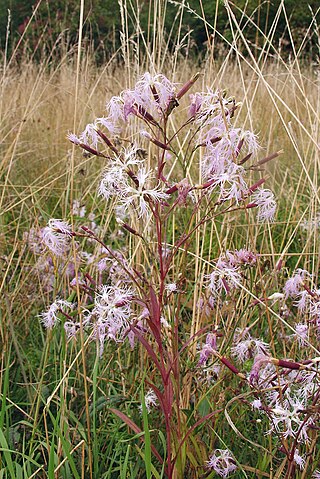
Dianthus superbus, the fringed pink or large pink, is a species of Dianthus native to Europe and northern Asia, from France north to arctic Norway, and east to Japan; in the south of its range, it occurs at high altitudes, up to 2,400 m.

Dianthus seguieri, common name Seguier's pink, is a herbaceous perennial plant of the genus Dianthus of the family Caryophyllaceae.
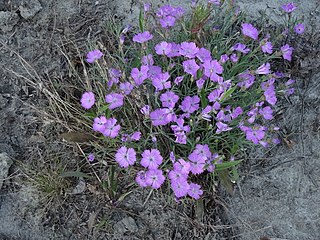
Dianthus repens, common names boreal carnation and northern pink, is a plant species native to the Nei Mongol region of China, as well as to Siberia, the Russian Far East, northern parts of European Russia, Alaska and Yukon Territory.
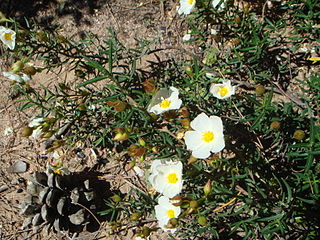
Cistus libanotis is a shrubby species of flowering plant in the family Cistaceae, with white flowers. It has been confused with Cistus clusii, which it resembles, resulting in some uncertainty in its distribution. It is endemic to the Iberian Peninsula.

Iris bismarckiana, the Nazareth iris, is a species in the genus Iris, it is also in the subgenus Iris and in the section Oncocyclus. It is a rhizomatous perennial, from the mountainsides of Israel, Lebanon, Jordan and Syria. It has stoloniferous, spreading rhizomes, long, sword shaped, bright green leaves, long slender stem and 1 flower in Spring. The large flower is pale yellow, creamy-white, or white background. Which is covered with reddish-brown, maroon brown, purple-brown, purple, blue-purple, or blue veins, markings or spots. It has a dark signal patch and dark purple to black beard. It is rarely cultivated as an ornamental plant in temperate regions, as it needs very dry conditions during the summer.

Dianthus strictus, known as the wild pink, is a species of flowering plant in the family Caryophyllaceae.
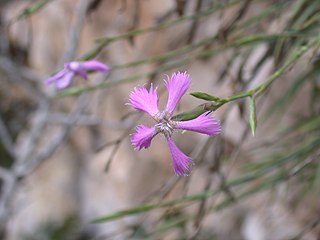
Dianthus pendulus is a herbaceous perennial plant belonging to the family Caryophyllaceae.
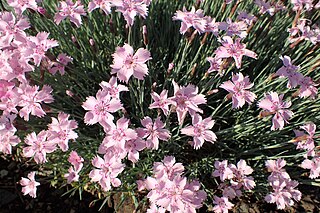
Dianthus plumarius, also known as the common pink, garden pink, wild pink or simply pink, is a species of flowering plant in the family Caryophyllaceae.

Klasea pusilla, is a species of flowering plant in the genus Klasea within the family Asteraceae. It is a native of the Eastern Mediterranean region.

Petrorhagia saxifraga, known as tunic flower or coat flower, is a small, herbaceous flowering plant in the family Caryophyllaceae. It is native to parts of Europe and introduced to the United States and Canada, Great Britain, and Sweden. Petrorhagia saxifraga is also known as tunic saxifrage, pink saxifrage, or just pink.

Romulea columnae, the sand crocus, is a herbaceous perennial in the family Iridaceae. It is a small plant, with thin narrow leaves, and small scape which has small pink, pale purple or violet pointed flowers with darker veining and a gold or yellow throat. It is native to a wide area ranging from western Europe to the Mediterranean.
Dianthus grossheimii, often called Grossheim's pink or Gvozdika Grossgejma, is native to Turkey and Transcaucasus. It is often found in mountain steppes and meadows.



















